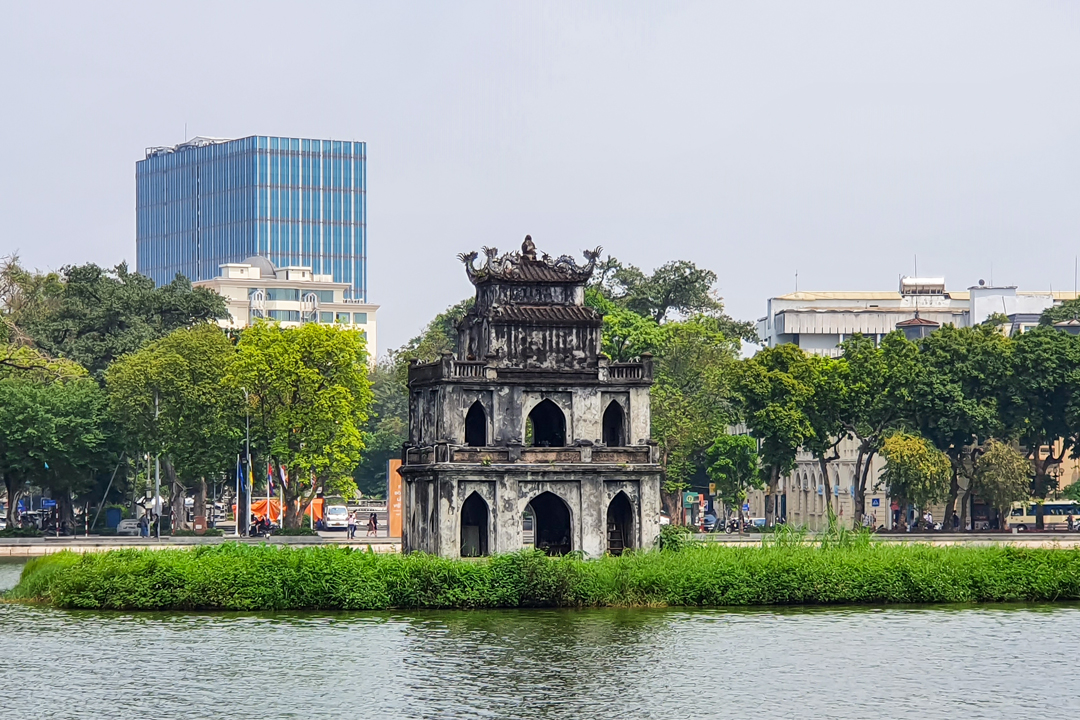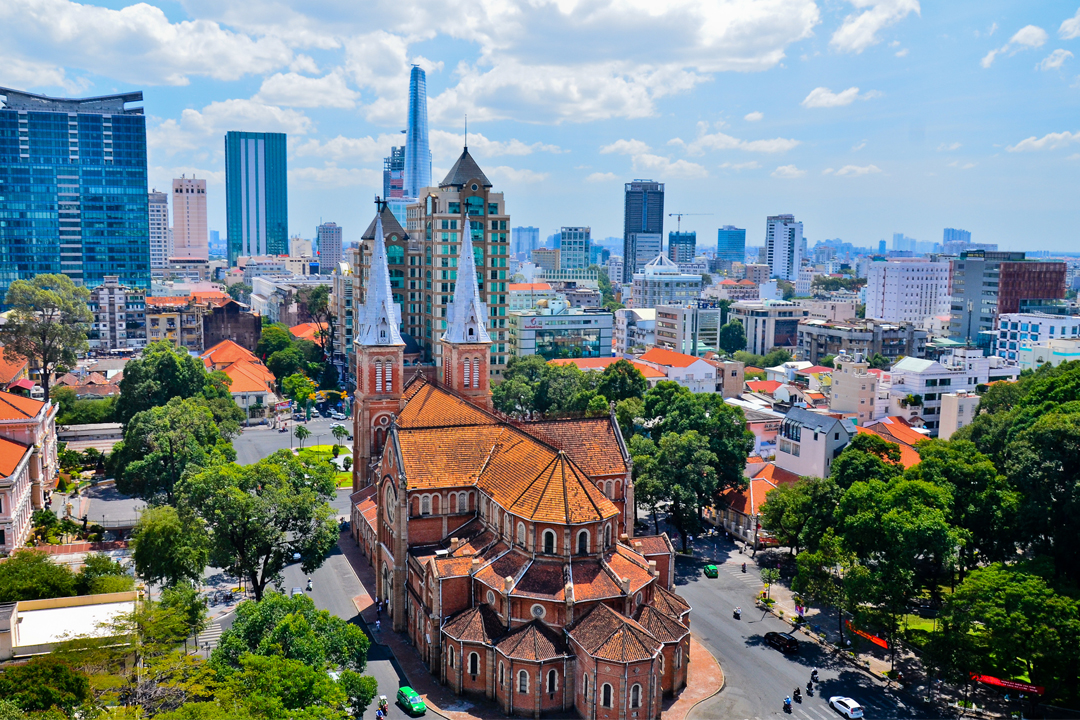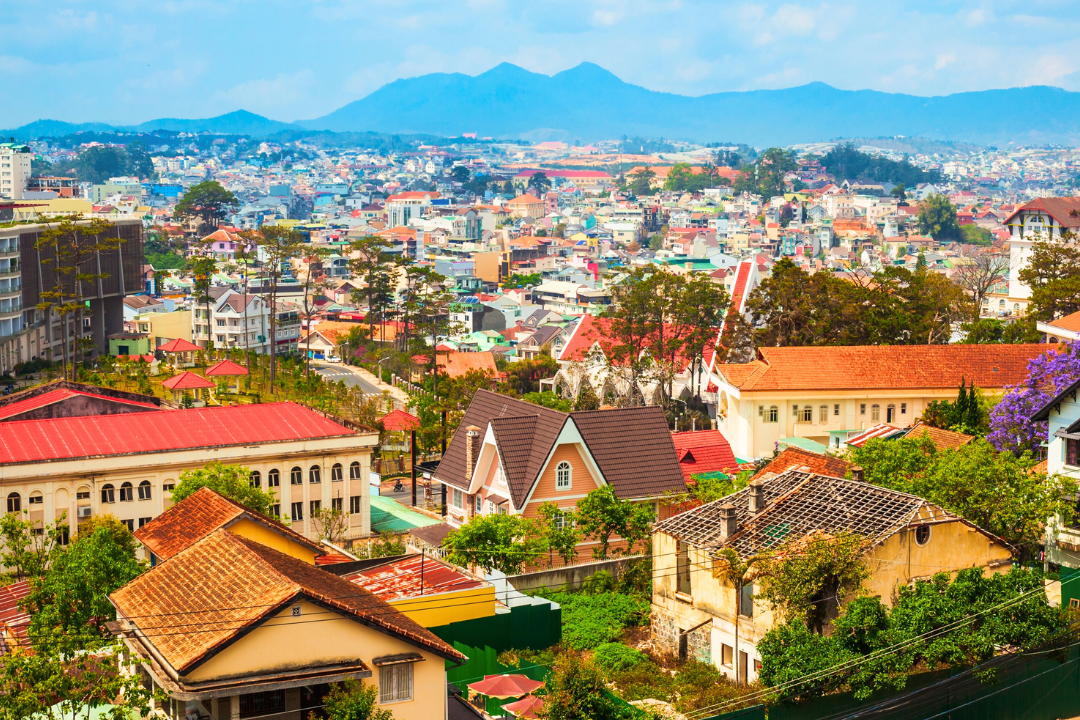Jun - 26 - 2025
Steeped in centuries of history and culture, the Vietnam Museum of Literature promises not just a glimpse but an immersive journey into the country's rich intellectual heritage. Tourists often find themselves captivated by the beauty and depth contained within its walls, where ancient stone steles whisper stories of a time when scholars and poets shaped Vietnam's identity. As you wander through this iconic museum, you'll experience Vietnam’s dedication to learning and scholarship, which continues to resonate in contemporary Vietnamese society.
Where is the Vietnam Museum of Literature located?
Vietnam Museum of Literature, officially known as "Bao tang Van hoc Viet Nam" is situated at 275 Au Co Street in Quang An Ward, Tay Ho District. This literary institution occupies a prime location overlooking the scenic West Lake area. The museum's strategic positioning makes it accessible to tourists exploring Hanoi's cultural landscape.
This prestigious institution is nestled in an area known for its intellectual significance and natural beauty. Tay Ho District, home to diplomatic residences and upscale venues, provides an appropriate setting for a museum celebrating Vietnam's rich literary traditions. The specific location offers tourists a peaceful environment away from downtown Hanoi's hustle, yet remains easily reachable by various transportation methods.

The Vietnam Museum of Literature stands as a cultural beacon in Hanoi's upscale Tay Ho District
Vietnam Museum of Literature ticket fees and opening hours
Planning your visit to the Vietnam Museum of Literature requires understanding its admission costs and operational hours. This cultural landmark offers reasonably priced entry, making it accessible for both international tourists and budget-conscious travelers. Below, you'll find comprehensive details about ticket pricing, special rates, and when you can explore this historical gem.
Admission costs and special rates
The Vietnam Museum of Literature maintains affordable entry fees with special considerations for various visitor categories. The tiered pricing structure ensures accessibility for diverse travelers:
Standard ticket pricing:
- Adult visitors: 20,000 VND (approximately $0.77)
- University, college, and vocational students: 15,000 VND ($0.58) with a valid student ID
- School students: 15,000 VND ($0.58) for primary and secondary education levels
- Children under 6 years: Free admission
- People with severe disabilities: Free entry as per Vietnamese regulations
- Senior citizens and eligible groups: 50% discount (10,000 VND) according to current regulations
For photography enthusiasts and content creators, additional fees apply:
- Photography permit: 15,000 VND per camera
- Video recording permit: 30,000 VND per camera
These photography and filming fees help preserve the cultural artifacts while allowing tourists to capture memories of their experience. For context, the current exchange rate hovers around 1 USD ≈ 26,000 VND, making the museum extremely affordable for international travelers.
Visiting hours and schedule
The Vietnam Museum of Literature welcomes tourists throughout the week with a brief afternoon closure. It opens from 8:00 AM to 12:00 PM and reopens from 1:30 PM to 5:00 PM. Key points about the museum's schedule:
- Open seven days a week (Monday through Sunday)
- Midday break from 12:00 PM to 1:30 PM
- Special holiday schedules are announced separately
- The last entry is typically 30 minutes before closing time
The regular operation throughout the week makes it easy to incorporate this cultural destination into your Vietnam itinerary. For those visiting during major Vietnamese holidays like Tet (Lunar New Year) or National Day, it's advisable to check the museum's official announcements for any schedule adjustments. Most tourists spend approximately 1-2 hours exploring the exhibits, so plan your visit accordingly to ensure you have sufficient time to appreciate the collections before closing hours.
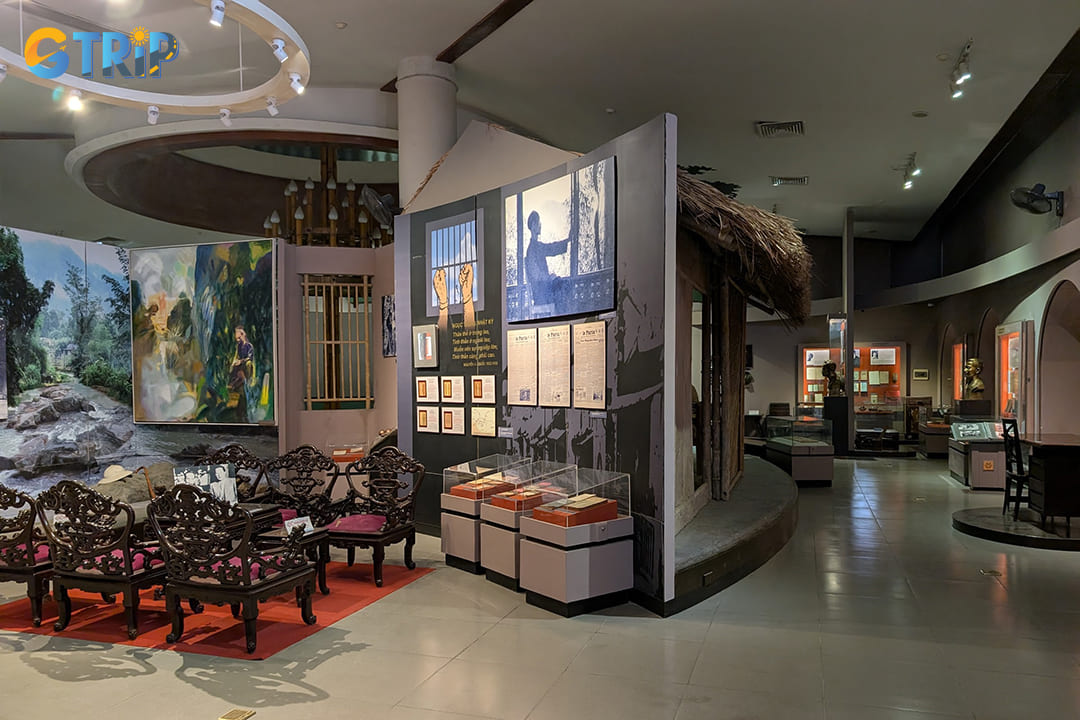
This cultural landmark offers reasonably priced entry, making it accessible for both international tourists and budget-conscious travelers
The history of the Vietnam Museum of Literature
The Vietnam Museum of Literature emerged from a vision to preserve Vietnam's rich literary heritage spanning thousands of years. Its journey from concept to cultural landmark took nearly two decades, overcoming numerous challenges along the way. Today, it stands as Southeast Asia's first national museum dedicated exclusively to literature.
From concept to reality
The idea to establish a museum celebrating Vietnamese literature first emerged in 1995 among literary scholars and cultural preservationists. The Vietnam Writers' Association championed the concept, recognizing the need to safeguard Vietnam's literary treasures for future generations. Initial plans faced funding challenges and administrative hurdles that delayed the project for nearly a decade.
In 2004, the project gained significant momentum when the government allocated a 3,600-square-meter plot in Hanoi's Tay Ho District. Construction officially began in 2005, designed to create a space that would honor Vietnam's literary giants while reflecting traditional architectural elements. The foundation stone was laid during a ceremony attended by prominent writers, government officials, and cultural ambassadors.
Development milestones
The museum's establishment received formal approval in 2011, placing it under the management of the Vietnam Writers' Association. This milestone marked the project's transition from concept to official national cultural institution. During this period, extensive work began on curating collections and developing exhibition spaces.
Between 2011 and 2015, museum curators embarked on the monumental task of collecting artifacts from across Vietnam. Their efforts yielded:
- Over 4,000 original literary artifacts
- Rare manuscripts from Vietnam's most celebrated writers
- Personal belongings of literary figures
- Historical documents showcasing the evolution of Vietnamese literature
- Ancient texts dating back several centuries
Grand opening and cultural impact
After years of meticulous preparation, the Vietnam Museum of Literature officially opened its doors on June 26, 2015. Located on Au Co Street in Quang An Ward, the museum's inauguration ceremony attracted literary enthusiasts, scholars, and tourists from across Vietnam and beyond.
The opening exhibition featured items that had never before been displayed publicly, including:
| Exhibition category | Notable items |
|---|---|
| Ancient literature | Rare editions of classic works and original manuscripts |
| Colonial period | Works showing the influence of French literature on Vietnamese writing |
| War literature | Powerful writings from Vietnam's periods of conflict |
| Contemporary works | Modern literary achievements since Vietnam's reunification |
| Folk literature | Traditional stories and poems passed through generations |
Since its opening, the museum has become an essential cultural destination that bridges Vietnam's literary past with its present. It preserves the nation's written heritage while inspiring new generations of writers and readers to appreciate Vietnam's remarkable literary tradition.

The opening exhibition featured items that had never before been displayed publicly
The architecture of the Vietnam Museum of Literature
The Vietnam Museum of Literature boasts an impressive architectural design that seamlessly blends traditional Vietnamese aesthetics with modern functionality. Situated on a sprawling 3,600-square-meter campus in Hanoi's Tay Ho District, the museum offers visitors a cultural oasis. The exhibition area covers 2,700 square meters, providing ample space to showcase Vietnam's rich literary heritage.
The museum's setting within an artificial park environment creates a tranquil atmosphere that enhances the visitor experience. Lush greenery surrounds the main building, offering a peaceful retreat from Hanoi's bustling streets. The serene landscape complements the building's design, creating harmony between nature and architecture.
The architectural style reflects contemporary Vietnamese design while honoring traditional elements. The building features:
- Clean, modern lines with conventional Vietnamese motifs incorporated throughout the facade
- Floor-to-ceiling windows that maximize natural light in exhibition spaces
- Sustainable design elements, including natural ventilation and energy-efficient systems
- Thoughtful integration with the surrounding landscape architecture
- Materials that reference Vietnam's architectural heritage
The museum's layout spans three main exhibition floors, each dedicated to different periods of Vietnamese literary history. The ground floor typically houses medieval literature exhibitions, while the upper floors progress chronologically. This logical arrangement helps tourists understand the evolution of Vietnamese literature through the centuries. One of the museum's most striking features is its dual indoor-outdoor exhibition concept. Inside, climate-controlled galleries protect delicate manuscripts and artifacts. The outdoor spaces particularly celebrate renowned literary figures through carefully crafted statues. You can find representations of Ho Xuan Huong, known for her bold poetry, and Tu Xuong, famed for his satirical works. These artistic elements transform the museum grounds into an accessible cultural environment where literature comes to life.
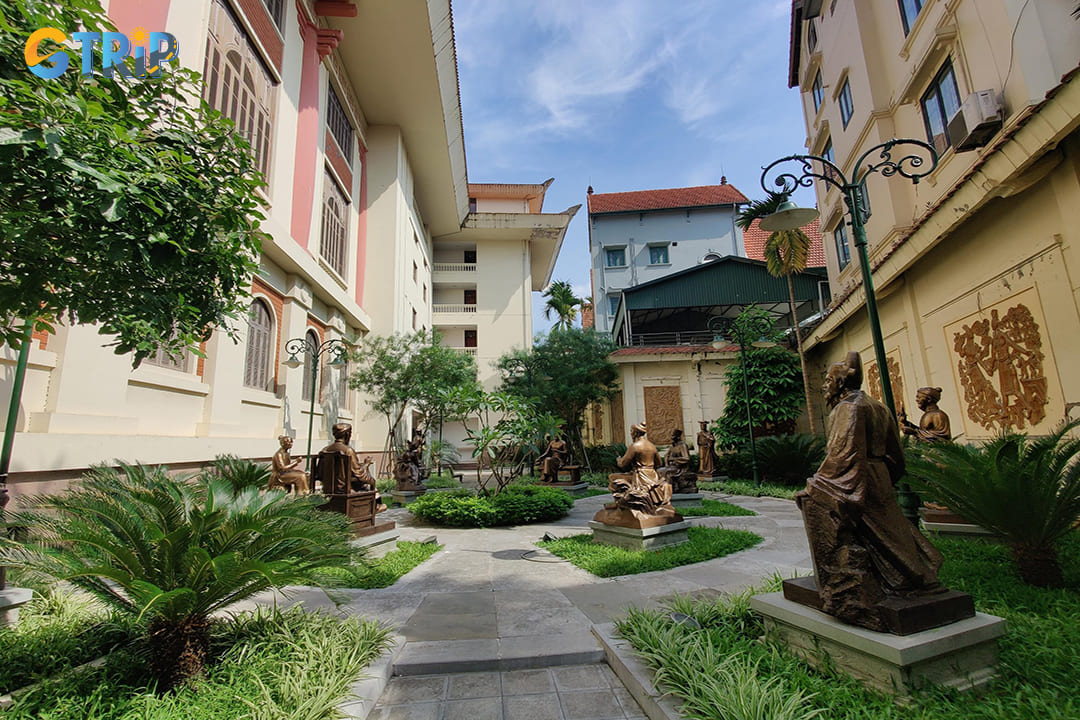
One of the museum's most striking features is its dual indoor-outdoor exhibition concept
What to expect from the exhibitions at the Vietnam Museum of Literature?
The Vietnam Museum of Literature offers a comprehensive journey through the nation's literary heritage with its thoughtfully curated exhibitions spread across two distinct zones. You can explore both indoor and outdoor spaces that showcase Vietnam's rich literary tradition spanning over ten centuries. The museum's exhibitions balance historical artifacts with interactive displays, providing an immersive experience for literature enthusiasts and casual tourists alike.
Outdoor exhibition
The outdoor exhibition area serves as a captivating introduction to Vietnam's literary landscape. Well-maintained grounds feature an impressive collection of ceramic reliefs that bring Vietnamese folk literature to life through visual storytelling. These artistic installations provide context to the oral traditions that shaped Vietnam's cultural identity long before written records became common.
Twenty carefully crafted statues dot the landscape, each commemorating influential figures who made significant contributions to Vietnamese literature from ancient times through the medieval period. These statues are arranged chronologically, allowing you to trace the evolution of literary movements and influences throughout Vietnam's history.
The most striking feature of the outdoor exhibition is the pen-shaped stone monument that stands as a powerful symbol of the written word. This monument represents:
- The enduring importance of scholarship in Vietnamese culture
- The transformative power of writing and education
- Vietnam's commitment to preserving its national literary identity
- The connection between literature and independence
Many tourists find the outdoor area particularly photogenic, especially in the morning light when the stone monuments cast interesting shadows across the grounds.
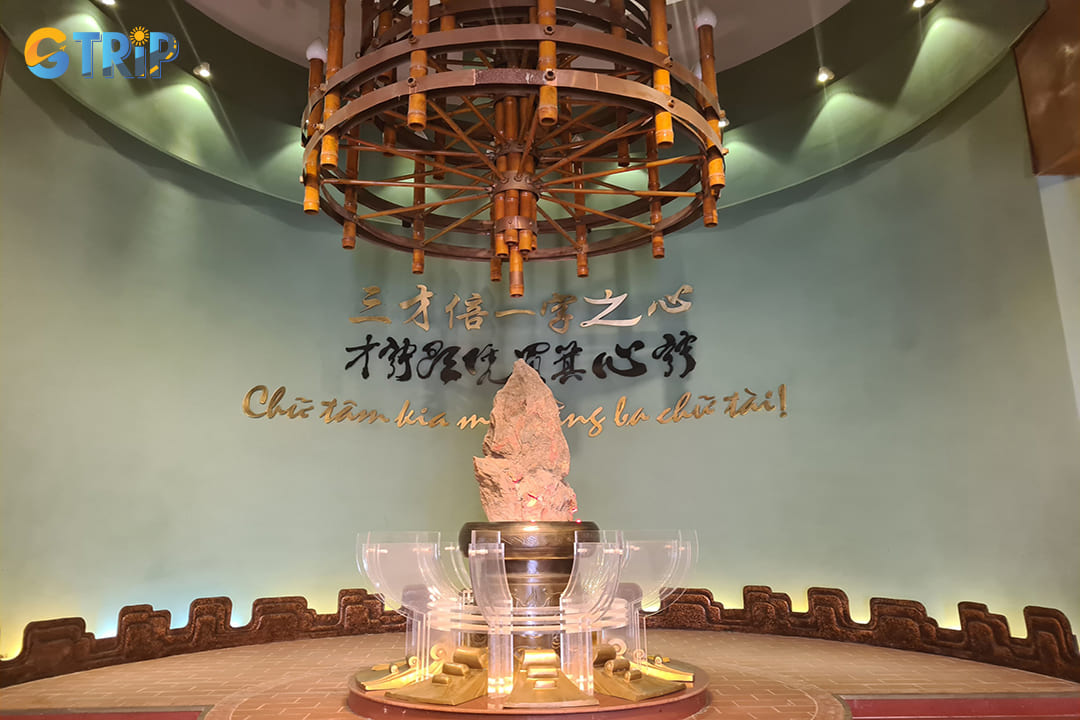
The most striking feature of the outdoor exhibition is the pen-shaped stone monument that stands as a powerful symbol of the written word
Indoor exhibition
First floor
The first floor serves as the welcoming gateway to the museum's indoor collections. This reception area provides an orientation to Vietnamese literature with informative displays that establish a foundation for understanding the exhibits on the upper floors.
The main exhibition on this level focuses on the earliest documented Vietnamese literary works dating from the 10th century through the 19th century. Displays include:
- Rare manuscripts preserved in climate-controlled cases
- Stone steles with inscribed poems and prose
- Woodblock prints were used for early book production
- Personal items belonging to notable scholars
A particularly fascinating section details Vietnam's traditional educational and examination systems during the 19th century. Interactive displays explain the rigorous civil service examinations that select government officials based on their literary knowledge and composition skills. You can view examples of examination papers, learn about testing protocols, and understand how this meritocratic system shaped Vietnamese society.
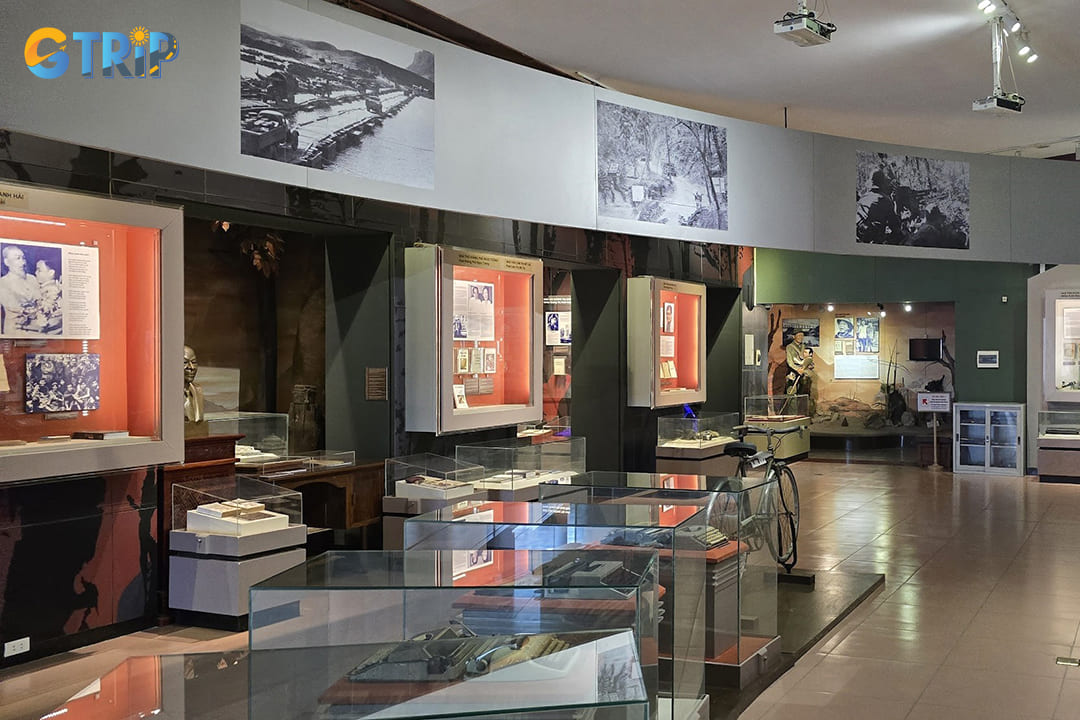
The main exhibition on this level focuses on the earliest documented Vietnamese literary works dating from the 10th century through the 19th century
Second floor
The second floor shifts focus to more contemporary works, showcasing the vibrant evolution of Vietnamese literature during the 20th century. This level gives special prominence to writers who received the prestigious Ho Chi Minh Prize for their literary achievements.
| Literary period | Key features | Notable authors |
|---|---|---|
| Early 20th Century | Transition from classical to modern forms | Nam Cao, Vu Trong Phung |
| War literature | Works depicting resistance and national identity | To Huu, Nguyen Dinh Thi |
| Post-war period | Social reconstruction themes | Nguyen Minh Chau, Ma Van Khang |
| Contemporary | Modern Vietnamese society and global influences | Bao Ninh, Duong Thu Huong |
One of the most historically significant exhibits is the "Xom Choi Space", a recreation of the former headquarters of the Vietnam Arts and Literature Association during the resistance against French colonialism. This atmospheric installation gives visitors insight into how writers continued their craft during periods of national struggle, using literature as a tool for cultural preservation and resistance.
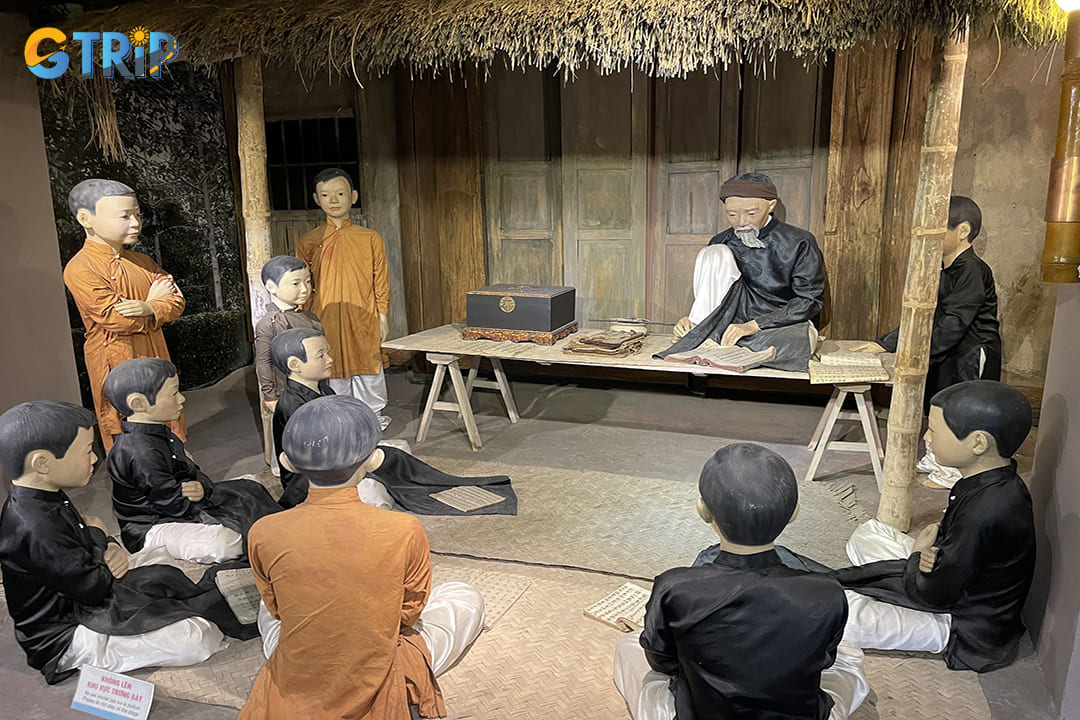
One of the most historically significant exhibits is the "Xom Choi Space"
Third floor
The third floor honors Vietnam's literary luminaries with displays dedicated to State Prize-winning writers. Comprehensive documentation of the National Congresses of the Vietnam Writers Association offers insight into the evolution of literary organizations and their role in shaping national culture.
This floor balances public exhibition space with functional areas, including:
- Research facilities with digital archives for scholarly work
- A specialized library containing rare and contemporary literary works
- Conference rooms for literary events and discussions
- Administrative offices supporting museum operations
The exhibition design on this floor employs modern technology, including:
- Interactive touchscreens allow you to browse digital collections
- Audio stations featuring readings of famous works
- Video installations showing interviews with prominent contemporary authors
- Augmented reality elements bring historical literary scenes to life
Beyond the standard exhibits, the museum features thematic display rooms that host rotating exhibitions on specialized topics such as children's literature, poetry movements, or wartime writing. These temporary exhibits ensure repeat tourists always discover something new.
The "Vietnamese Rural Cultural Space" stands out as one of the museum's most memorable features. This interactive installation recreates elements of traditional village life, demonstrating how rural settings influenced folk literature and storytelling traditions. You can experience:
- A replica of a traditional communal house where stories were shared
- Agricultural tools with associated folk sayings and proverbs
- Traditional musical instruments used in storytelling performances
- Seasonal decorations are connected to literary festivals throughout the year
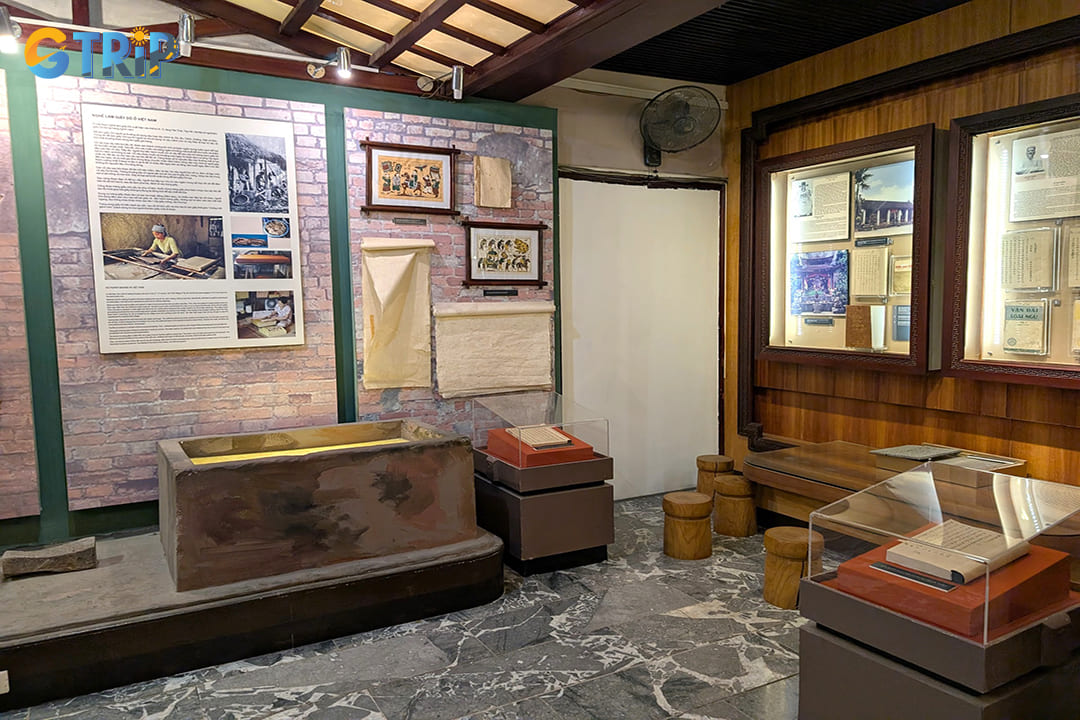
The "Vietnamese Rural Cultural Space" stands out as one of the museum's most memorable features
Things to do at the Vietnam Museum of Literature
The Vietnam Museum of Literature offers you a multi-dimensional journey through the country's rich literary heritage. Beyond merely viewing artifacts, guests can immerse themselves in interactive experiences, join specialized tours, and develop a deeper appreciation for Vietnam's literary giants. Here are the most enriching activities to enjoy during your visit.
Explore rare literary artifacts and ancient manuscripts
The museum houses an impressive collection of valuable literary artifacts that spans centuries of Vietnamese intellectual history. You can marvel at the large stone shaped like a pen nib, transported from the historic Hung Temple in Phu Tho Province. This symbolic artifact represents the lasting power of the written word in Vietnamese culture.
The collection features diverse manuscripts, documents, and personal items belonging to Vietnam's most influential authors throughout history. Many items provide intimate glimpses into the lives and creative processes of literary icons who shaped the nation's cultural identity. You can study ancient writing implements, personal correspondence, and original drafts that reveal the evolution of ideas.
The museum's chronological arrangement allows guests to witness the progression of Vietnamese literature from medieval times to contemporary works. Ancient bamboo and wooden tablets sit alongside more modern publications, demonstrating how literary traditions have adapted over centuries while maintaining cultural significance. Preservation efforts have ensured these fragile documents remain accessible to modern audiences interested in Vietnam's intellectual heritage.

The museum houses an impressive collection of valuable literary artifacts that spans centuries of Vietnamese intellectual history
Engage with interactive and multimedia storytelling
The museum's signature offering is the "Chu Tam, Chu Tai" (The Heart and the Talent) literary tour, a 90-minute immersive journey. This deeply engaging experience guides tourists through the statue garden featuring twenty of Vietnam's most celebrated literary icons. Guides provide context and stories that bring these historical figures to life.
The tour introduces participants to Han and Nom scripts, ancient writing systems that formed the foundation of Vietnamese literary tradition. Multimedia presentations enhance understanding by demonstrating how these complex character systems evolved and influenced Vietnamese cultural expression. Interactive elements allow you to gain hands-on appreciation for the technical skills required by early Vietnamese scholars.
Discover the creative stories behind Vietnam's great writers
The museum's biographical exhibits celebrate legendary figures who shaped Vietnamese literary tradition through their innovative works and cultural impact. You can explore dedicated spaces for poet Nguyen Du, author of the epic masterpiece "The Tale of Kieu", which remains central to Vietnamese cultural identity. His personal journey from aristocrat to wandering poet reflects Vietnam's turbulent history.
Scholar Nguyen Trai, celebrated as both a national liberation hero and literary genius, receives special attention for his poetry. Other prominent figures include the blind patriotic poet Nguyen Dinh Chieu, realist writer Nam Cao, revolutionary poet To Huu, and beloved storyteller To Hoai. Each writer's display includes biographical information, representative works, and cultural context.
The exhibits go beyond basic biographical information to reveal the personal struggles and creative inspirations of these literary giants. Tourists learn how political upheaval, personal tragedy, and cultural transformation influenced these writers' distinctive voices and literary contributions. The presentations humanize these historical figures while explaining their lasting significance in Vietnamese cultural heritage.
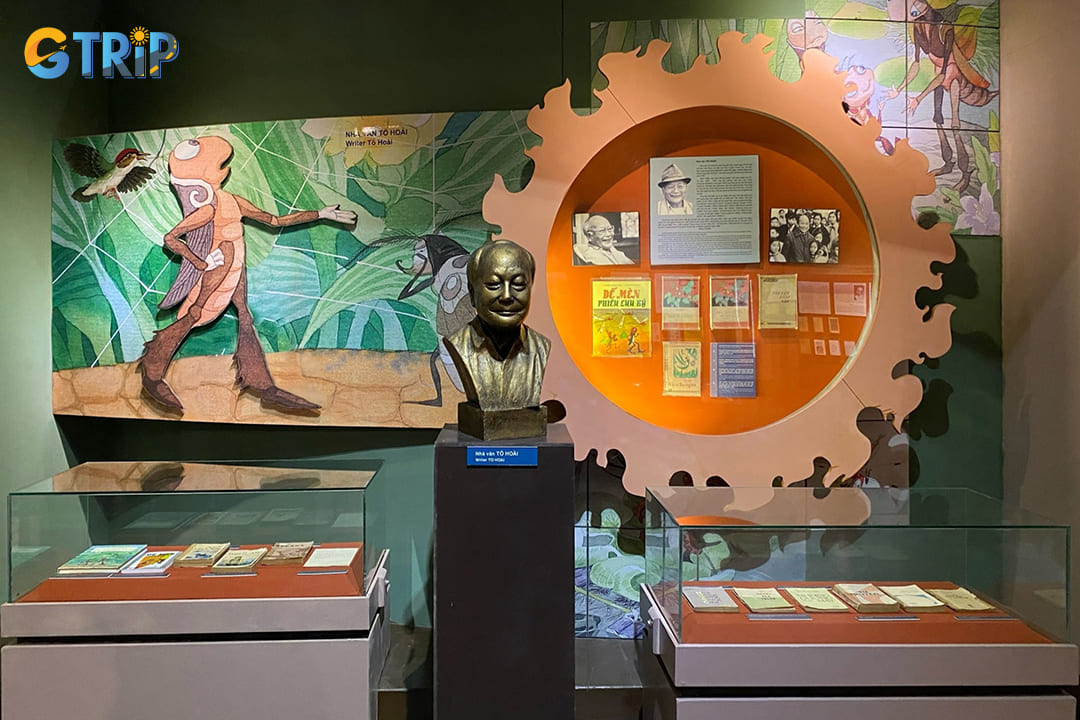
The museum's biographical exhibits celebrate legendary figures who shaped Vietnamese literary tradition through their innovative works and cultural impact
Learn about Vietnamese literary history from the Ly Dynasty onward
The museum's chronological exhibits provide a comprehensive overview of Vietnam's literary development since the Ly Dynasty (1009-1225). This era marked Vietnam's first golden age of literature, when poetry and scholarly works flourished under royal patronage. You can trace how political changes influenced literary themes and styles over the centuries.
During the Le and Nguyen dynasties, Vietnamese literature embraced diverse genres while maintaining connections to Chinese literary traditions. The museum explains how Vietnamese writers developed unique approaches that reflected local experiences while drawing from regional influences. Detailed timelines help tourists understand how historical events shaped Vietnam's literary movements.
The exhibits continue through the colonial period and the revolution, showing how literature became a vehicle for national identity. Modern and contemporary literature sections demonstrate Vietnam's literary evolution through periods of war, reconstruction, and globalization. The displays help visitors appreciate how Vietnamese writers have continuously adapted to changing social conditions while preserving cultural values.
Join the night tour at the Vietnam Literature Museum
The atmospheric evening program "Chu Tam, Chu Tai" transforms the museum experience with dramatic lighting and specialized interpretation. These tours operate every Saturday and Sunday evening at 6:00 PM and 7:00 PM, offering a unique perspective on the collections. The 90-minute guided experience creates a more intimate connection with Vietnamese literary history.
Tickets cost 150,000 VND per adult, representing excellent value for this enhanced museum experience. You can purchase tickets directly at the Museum of Literature at least 30 minutes before tour departure. Alternatively, bookings can be made through the official 'Chu Tam, Chu Tai' Night Tour Facebook page for those who prefer to secure spots in advance.
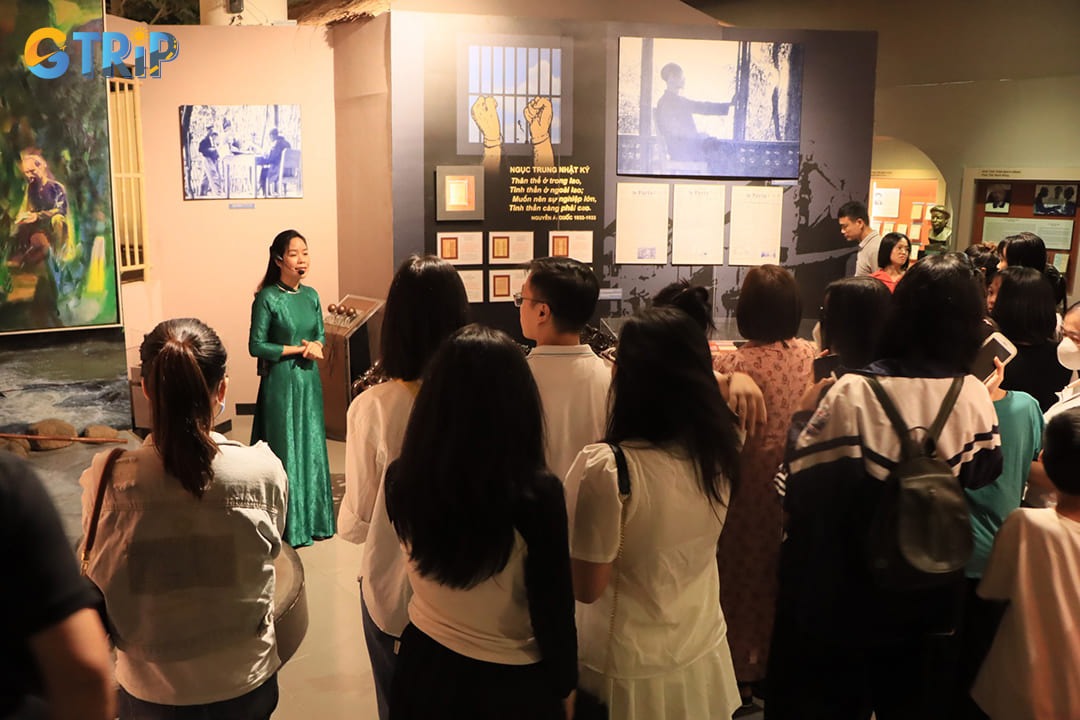
The atmospheric evening program "Chu Tam, Chu Tai" transforms the museum experience with dramatic lighting and specialized interpretation
Participate in thematic exhibitions and special cultural programs
The museum regularly hosts rotating thematic exhibitions that explore specific literary movements, historical periods, or artistic connections. These special exhibits often feature rare items from private collections or international partnerships that aren't normally on display. You should check the museum's schedule when planning your visit to catch these unique opportunities.
Cultural programs include poetry readings, calligraphy demonstrations, and scholarly lectures enhance the visitor experience. These events typically coincide with significant dates in Vietnamese literary history or seasonal celebrations. International visitors particularly appreciate the English-language programs that make Vietnamese literary traditions more accessible.
Educational workshops offer hands-on experiences with traditional literary practices, including calligraphy, paper-making, and poetry composition. These participatory activities provide deeper cultural understanding than passive observation alone. Family-friendly programs introduce younger tourists to Vietnamese folktales and literary traditions through age-appropriate activities.
How to get to the Vietnam Museum of Literature?
Reaching the Vietnam Museum of Literature is straightforward with several transportation options available for tourists. Depending on your preferences, budget, and location in Hanoi, you can choose between public transportation, private vehicles, or rental options. Each method offers different advantages in terms of cost, convenience, and flexibility.
By bus
Hanoi's public bus system provides an affordable and convenient way to reach the Vietnam Museum of Literature. Bus routes 31, 33, 41, 55, and 58 all stop within walking distance of the museum entrance. Each bus is clearly marked with its route number on the front and side panels.
The standard bus fare in Hanoi ranges from 7,000 to 9,000 VND (approximately $0.30 - 0.40) per journey, making it the most economical option. Buses typically operate from early morning around 5:30 AM until 9:00 PM, with services running every 15 - 20 minutes during peak hours.
For travelers staying in the Old Quarter, route 31 offers the most direct connection to the museum. When approaching your stop, listen for announcements or watch for Quoc Tu Giam Street, where the museum is located.
By taxi or ride-hailing apps
Taxis provide a comfortable and direct transportation option to the Vietnam Museum of Literature, especially during hot or rainy days. Most Hanoi taxis are metered, with fares typically ranging from 11,000 VND to 20,000 VND per kilometer.
Reliable taxi companies in Hanoi include Mai Linh (green taxis), Vinasun (white taxis), and Group Taxi. Always ensure the driver turns on the meter before starting your journey to avoid price disagreements later.
Ride-hailing apps like Grab offer a convenient alternative with pre-set pricing. Current fare estimates from the Old Quarter to the museum are:
- GrabCar (4-seater): VND 250,000 - 350,000 (USD 10-15)
- GrabCar (7-seater): VND 300,000 - 450,000 (USD 12-19)
- GrabTaxi: Prices calculated based on the meter
Most drivers speak limited English, so having the museum's address written in Vietnamese (Van Mieu-Quoc Tu Giam, 58 Quoc Tu Giam, Dong Da, Hanoi) can help ensure a smooth journey.
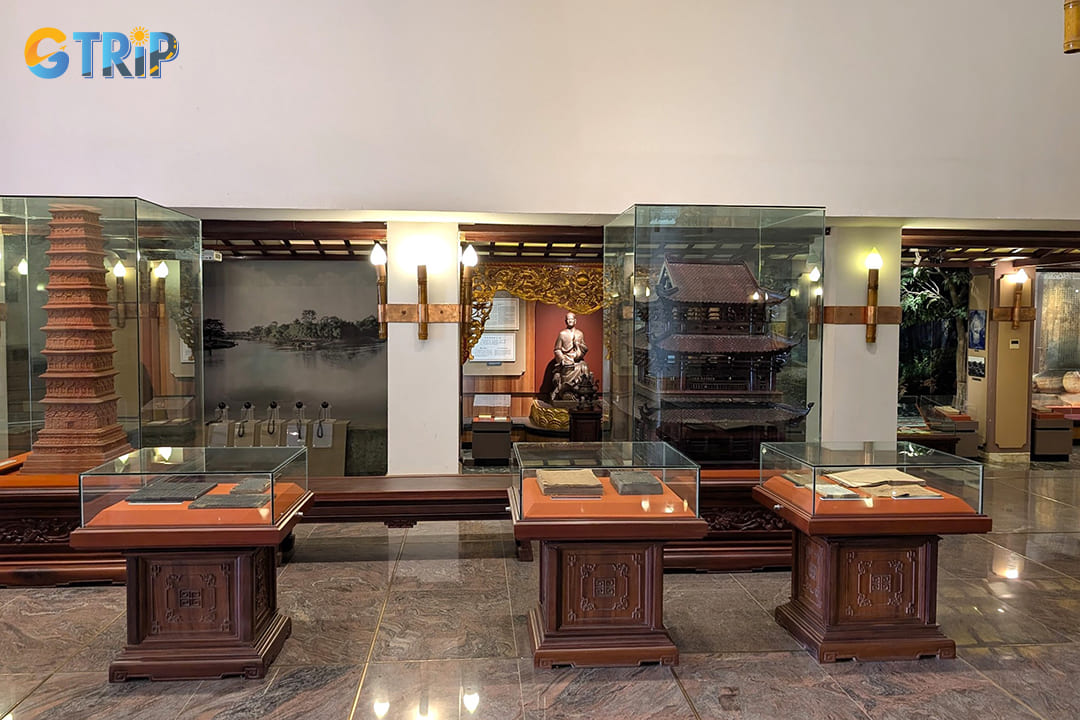
Reaching the Vietnam Museum of Literature is straightforward with several transportation options available for tourists
By motorbike or car rental
Renting a motorbike offers flexibility and convenience for exploring Hanoi, including visits to the Vietnam Museum of Literature. Standard motorbike models typically cost between 150,000 VND to 200,000 VND (approximately $5 to $8) per day in Hanoi.
Reputable rental shops include Style Motorbikes, Tigit Motorbikes, and Rent A Bike Hanoi. Most require a passport as a deposit and provide helmets with rentals. An international driving permit is technically required for legal operation.
For those preferring four wheels, car rentals start from around 580,000 VND per day (approximately $22). Companies like Avis, Budget, and local providers offer services with or without drivers. Self-driving requires an International Driving Permit and familiarity with local traffic conditions.
Parking is available near the museum entrance for a small fee of 5,000-10,000 VND for motorbikes and 20,000-30,000 VND for cars. Always lock your vehicle and remove valuables when parking.
Tips for first-time visitors to the Vietnam Museum of Literature
The Vietnam Museum of Literature offers a deep dive into the country's rich literary heritage, but knowing how to approach your visit can significantly enhance your experience. Here are essential tips to make your first visit both enjoyable and educational:
- Plan your visit during optimal hours: Arriving early in the morning (between 8:00-9:30 AM) typically means fewer visitors and a more contemplative atmosphere. Weekdays generally see fewer crowds than weekends.
- Allocate sufficient time: A thorough visit requires at least 1.5 - 2 hours. The complete experience includes exploring three floors of indoor exhibits plus the expansive outdoor area featuring gardens and architectural elements.
- Dress appropriately: Wear comfortable walking shoes and weather-appropriate clothing. The outdoor areas offer limited shade during summer months, so consider bringing a hat and sunscreen during hot weather.
- Consider hiring a guide: While signage includes English translations, the deeper cultural context can be missed without guidance. The museum's special "Chu Tam, Chu Tai" literary tour provides fascinating insights into Vietnamese literary icons, ancient Han and Nom scripts, and cultural practices.
- Bring photography equipment: The museum permits photography (without flash in certain sections), and the architecture, courtyards, and exhibits offer excellent photo opportunities. Consider bringing a camera with a decent zoom lens.
- Respect the space: As a cultural institution dedicated to Vietnam's literary traditions, maintain appropriate volume, follow no-touch policies for artifacts, and observe any special instructions from staff.
- Check the museum's calendar: Occasionally, the museum hosts special events, workshops on traditional arts like calligraphy, and temporary exhibitions that aren't included in regular promotional materials. Check their official website or inquire at tourist information centers about current happenings.
The museum shop near the exit offers unique souvenirs related to Vietnamese literature and culture, including calligraphy items, reproductions of ancient texts, and books about Vietnamese literary history.
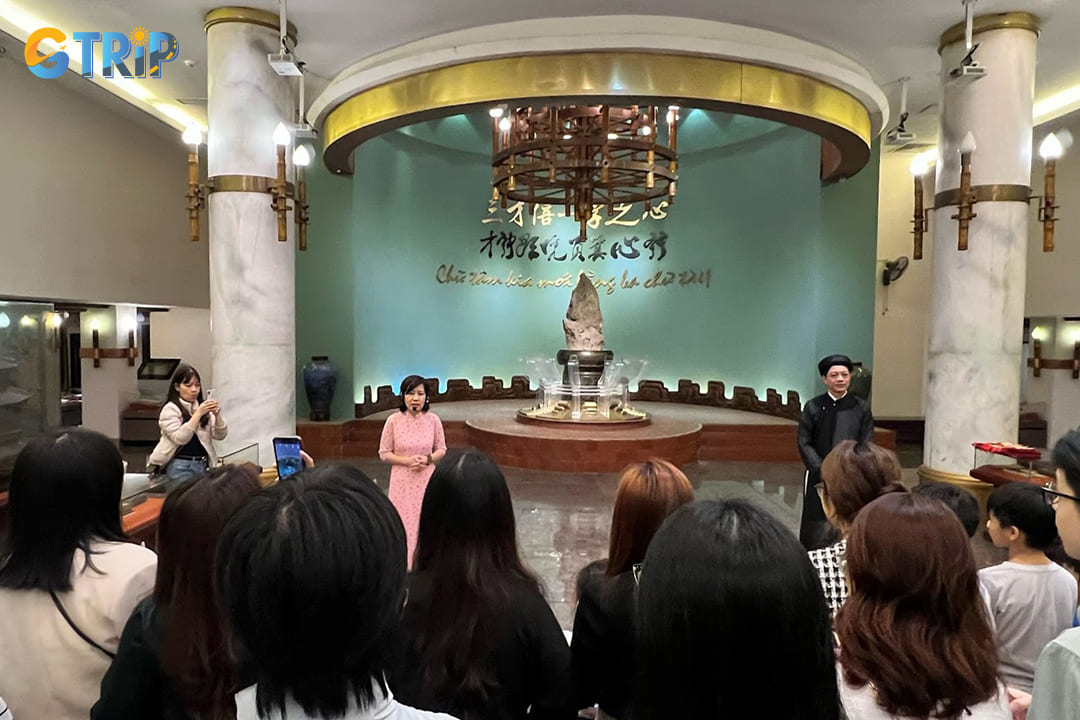
While signage includes English translations, the deeper cultural context can be missed without guidance
Nearby attractions from the Vietnam Museum of Literature
After exploring Vietnam's rich literary heritage, tourists to the Museum of Literature can continue their cultural journey at several nearby attractions. Hanoi's Tay Ho district offers a variety of experiences within easy walking or short driving distance. These nearby destinations provide perfect complements to your museum visit, allowing you to experience more of Hanoi's natural beauty and recreational offerings.
West Lake (1km)
West Lake, known locally as Ho Tay, stands as Hanoi's largest freshwater lake just a short 15-minute walk from the Museum of Literature. Spanning approximately 500 hectares, this scenic urban lake offers a peaceful retreat from the bustling city center. You can stroll along the 17km shoreline promenade while enjoying spectacular sunset views across the tranquil waters.
The lake area houses numerous historic temples and pagodas, including the picturesque Tran Quoc Pagoda dating back over 1,500 years. Local food vendors line portions of the shoreline, serving traditional Vietnamese snacks and the area's famous shrimp cakes. You can rent swan-shaped paddle boats for a leisurely lake excursion or simply relax at one of the lakeside cafes.
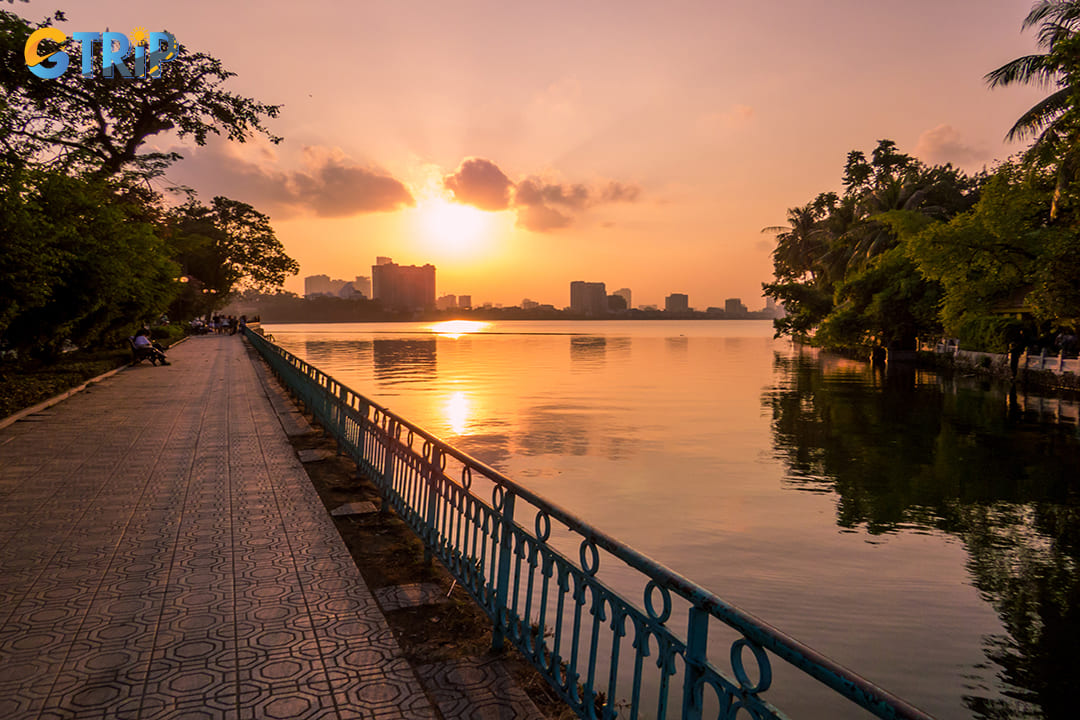
West Lake, known locally as Ho Tay, stands as Hanoi's largest freshwater lake just a short 15-minute walk from the Museum of Literature
West Lake Flower Valley (1.2km)
West Lake Flower Valley is located at the intersection of Nhat Chieu Street in Nhat Tan Ward, this vibrant garden attraction offers a colorful contrast to your museum experience. The flower valley covers several hectares of meticulously maintained gardens featuring seasonal Vietnamese and imported flower varieties. You can wander through pathways lined with sunflowers, roses, daisies, and numerous tropical blooms, depending on the season.
The garden provides excellent photo opportunities with dedicated scenic spots and flower arrangements changing throughout the year. Morning visits offer the best lighting conditions and smaller crowds, making it ideal for photography enthusiasts. The valley includes small cafes serving refreshments and light meals, perfect for a break after walking through the floral displays.
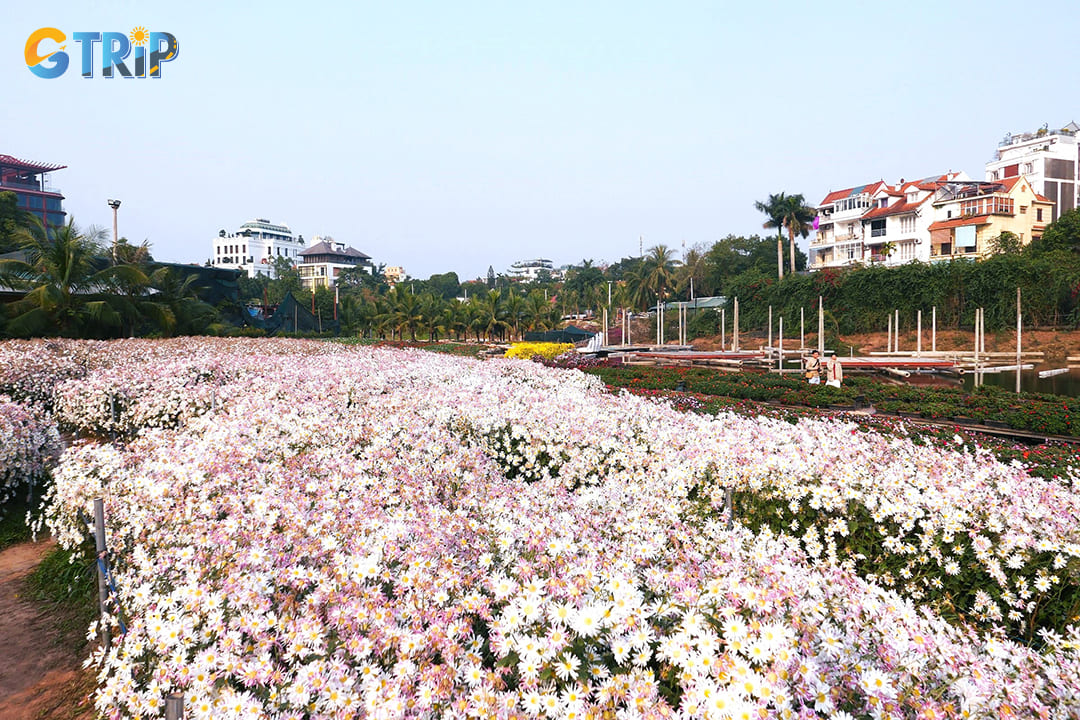
The flower valley covers several hectares of meticulously maintained gardens featuring seasonal Vietnamese and imported flower varieties
Ho Tay Water Park (1.5km)
Ho Tay Water Park is located at 614 Lac Long Quan Street, this family-friendly water park offers exciting aquatic adventures just minutes from the Museum of Literature. The park features multiple swimming pools, water slides of varying heights, and splash zones appropriate for different age groups. You can enjoy thrilling water rides, including the Tornado, Kamikaze, and family raft adventures. The facility provides changing rooms, lockers, and rental services for towels and swimming accessories for visitors' convenience. Food courts within the complex serve Vietnamese favorites and international options, making it easy to spend a full afternoon here. Safety measures include lifeguards stationed throughout the park and height requirements for certain attractions.

Ho Tay Water Park features multiple swimming pools, water slides of varying heights, and splash zones appropriate for different age groups
Visiting the Vietnam Museum of Literature offers a rich plunge into the heart of Vietnamese heritage. It provides glimpses into ancient scholarly traditions and profound insights into the country's deep-seated cultural values. Through this exploration, you've gained a window into Vietnam's historical tapestry, woven with intellect, resilience, and creativity. Such experiences fuel inspiration and curiosity. If you feel a lingering desire to delve deeper or wish to uncover other hidden gems in Vietnam, let this journey spark further exploration and planning. Consider booking Hanoi tours of GTrip - Vietnam Travel Agency if you want to explore this museum and other attractions in Hanoi.

